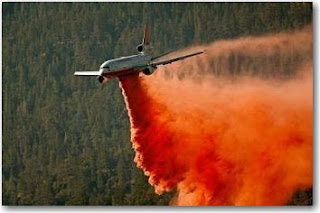 EDWARDS, Calif. — NASA is partnering with the U.S. Department of Agriculture's Forest Service on a project to examine the mission suitability of Boeing 747 and McDonnell Douglas DC-10 fire retardant delivery aircraft. The aircraft under study are a DC-10 belonging to 10 Tanker Air Carrier LLC and a 747 owned by Evergreen International Aviation, Inc. The DC-10 tanker has already been successfully employed by the California Department of Forestry and Fire Protection in past wildfire suppression missions.
EDWARDS, Calif. — NASA is partnering with the U.S. Department of Agriculture's Forest Service on a project to examine the mission suitability of Boeing 747 and McDonnell Douglas DC-10 fire retardant delivery aircraft. The aircraft under study are a DC-10 belonging to 10 Tanker Air Carrier LLC and a 747 owned by Evergreen International Aviation, Inc. The DC-10 tanker has already been successfully employed by the California Department of Forestry and Fire Protection in past wildfire suppression missions.NASA's Dryden Flight Research Center at Edwards Air Force Base, Calif., is working with the Forest Service to help determine the safe flight envelope for these very large air tanker aircraft for both the Forest Service and the U.S. Department of the Interior. Additionally, NASA Dryden will recommend operational usage regimes, policies and procedures for the aircraft. The Forest Service and the Interior Department approached NASA for help because NASA provides a range and depth of necessary flight test planning skills to develop and conduct the assessment.
Mark Dickerson, Dryden project manager, calls this important work.
"The entire team is very excited about helping the forest service with this effort. It is a bit different from our typical research projects, but we all enjoy being able to help find new tools to fight wildfires," Dickerson said.
As project lead, NASA Dryden is performing operational test and evaluation assessments. Project engineers will report findings and recommendations on these aircraft in cooperation with NASA's Ames Research Center at Moffett Field, Calif. NASA Ames' engineers are supporting the effort with pilot-in-the-loop simulations and are coordinating simulator models, flight profiles & data analysis with project staff at NASA Dryden.
Engineers at NASA Dryden will also develop,
 implement, and direct an evaluation test plan for use in flight test and in simulation. The test plan will be designed to evaluate the suitability of large tanker aircraft for the firefighting mission environment. Based on this analysis, NASA will propose appropriate interim flight envelope limitations to enhance safety and operational utility in the fire retardant delivery mission.
implement, and direct an evaluation test plan for use in flight test and in simulation. The test plan will be designed to evaluate the suitability of large tanker aircraft for the firefighting mission environment. Based on this analysis, NASA will propose appropriate interim flight envelope limitations to enhance safety and operational utility in the fire retardant delivery mission.NASA Dryden personnel are working with the crews of the large tanker aircraft to capture flight validation data, assess the effectiveness of proposed procedures, and refine those as required. The final project report will include initial recommendations for such factors as flight over various terrain types, density altitude limits, turbulence, and horizontal wind shear limits.




No comments:
Post a Comment